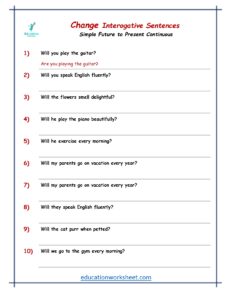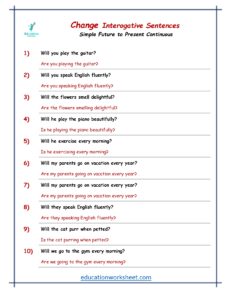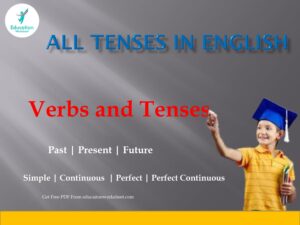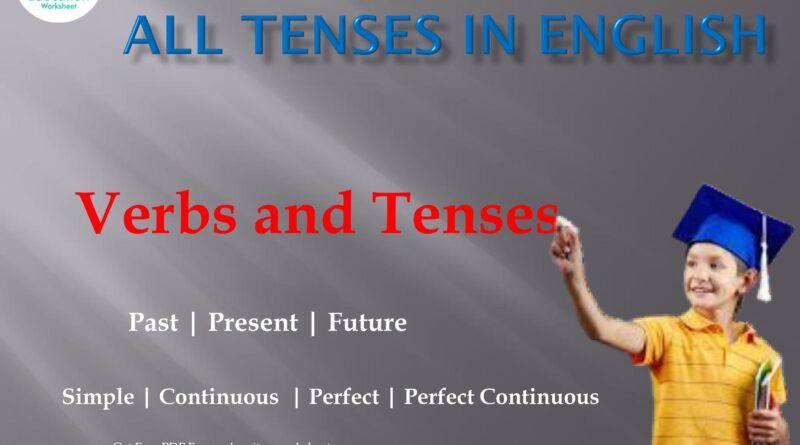Verbs and Tenses
Verbs and Tenses
Verbs and tenses form the core of English grammar, essential for conveying action and time in any sentence. Verbs, the words that express actions, states, or occurrences, come in various types, including action verbs (e.g., “run”), linking verbs (e.g., “is”), and helping verbs (e.g., “has”). These verbs can be further categorized as transitive or intransitive, depending on whether they require a direct object, and as regular or irregular based on their past tense formation. Phrasal verbs combine a verb with a preposition or adverb to create a distinct meaning (e.g., “give up”). Tenses, on the other hand, indicate the time of action or state described by the verb, encompassing past, present, and future time frames, each with simple, continuous, perfect, and perfect continuous aspects. The simple present tense describes habitual actions or general truths (“She runs”), while the present continuous tense depicts ongoing actions (“She is running”). The present perfect tense connects past actions to the present (“She has run”), and the present perfect continuous tense highlights actions that began in the past and continue (“She has been running”). Similarly, the simple past tense relates completed actions (“She ran”), the past continuous tense illustrates ongoing past actions (“She was running”), the past perfect tense refers to actions completed before another past event (“She had run”), and the past perfect continuous tense shows ongoing actions before a past moment (“She had been running”). For future actions, the simple future tense (“She will run”), future continuous tense (“She will be running”), future perfect tense (“She will have run”), and future perfect continuous tense (“She will have been running”) articulate different aspects of future activities. Mastery of verbs and tenses allows for precise and effective communication, enabling speakers and writers to clearly express when actions or states occur and their relationship to other events.
Verbs are action words or state-of-being words in a sentence, crucial for conveying what the subject does or experiences. Tenses, on the other hand, indicate the time of the action or state of being represented by the verb. Together Verbs and Tenses, they form the backbone of sentence structure and meaning in any language.
Main Details About Verbs and Tenses
Verbs are essential components of sentences that describe actions (e.g., “run,” “jump,” “write”) or states of being (e.g., “is,” “seem,” “become”). They can also express occurrences (e.g., “happen,” “occur”). Verbs are conjugated to match the subject in person (first, second, third) and number (singular, plural).
Example:
- Action Verb: “She runs every morning.”
- State-of-being Verb: “He is a teacher.”

Main Details About Verbs and Tenses
Tenses are grammatical categories that indicate the time when the action or state described by the verb takes place. The three main tenses are past, present, and future, each with its own variations to express different aspects of time and completeness.
Example:
- Present Tense: “She runs every morning.”
- Past Tense: “She ran yesterday.”
- Future Tense: “She will run tomorrow.”
Detailed Descriptions of Verbs
1. Action Verbs
Action verbs express specific activities performed by the subject of the sentence.
Examples:
- “He jumps over the fence.”
- “They write letters to their friends.”
2. Linking Verbs
Linking verbs connect the subject to additional information about the subject, often an adjective or a noun.
Examples:
- “She is a doctor.”
- “The soup tastes good.”
3. Helping (Auxiliary) Verbs
Helping verbs accompany main verbs to form a verb phrase that expresses tense, mood, or voice.
Examples:
- “She has finished her homework.”
- “They are going to the market.”
Detailed Descriptions of Tenses
1. Present Tense
The present tense describes actions happening now or regularly.
Simple Present Tense
- Usage: Describes habitual actions or general truths.
Examples:
- “The sun rises in the east.”
- Simple Present: “She runs every morning.”
- Present Continuous: “She is running right now.”
- Present Perfect: “She has run three miles today.”
- Present Perfect Continuous: “She has been running for an hour.”
Present Continuous Tense
- Usage: Describes ongoing actions happening now.
- Example: “She is reading a book.”
Present Perfect Tense
- Usage: Describes actions that occurred at an unspecified time or started in the past and continue to the present.
- Example: “They have visited France.”
Present Perfect Continuous Tense
- Usage: Describes actions that started in the past and are still continuing.
- Example: “She has been studying for three hours.”
2. Past Tense
The past tense describes actions that have already happened.
Examples:
- Simple Past: “She ran yesterday.”
- Past Continuous: “She was running when it started to rain.”
- Past Perfect: “She had run three miles before breakfast.”
- Past Perfect Continuous: “She had been running for an hour when I saw her.”
Simple Past Tense
- Usage: Describes completed actions in the past.
- Example: “He watched a movie yesterday.”
Past Continuous Tense
- Usage: Describes actions that were ongoing in the past.
- Example: “They were playing soccer when it started to rain.”
Past Perfect Tense
- Usage: Describes actions completed before another action in the past.
- Example: “She had finished her homework before dinner.”
Past Perfect Continuous Tense
- Usage: Describes actions that were ongoing before a specific moment in the past.
- Example: “He had been working for hours before he took a break.”
3. Future Tense
The future tense describes actions that will happen.

Simple Future Tense
- Usage: Describes actions that will happen in the future.
- Example: “She will travel to Japan next year.”
Future Continuous Tense
- Usage: Describes actions that will be ongoing in the future.
- Example: “They will be studying at this time tomorrow.”
Future Perfect Tense
- Usage: Describes actions that will be completed before a specific future time.
- Example: “She will have completed her project by next week.”
Future Perfect Continuous Tense
- Usage: Describes actions that will continue up to a point in the future.
- Example: “He will have been working at the company for ten years by next month.”
Verbs: Types and Functions
1. Transitive and Intransitive Verbs
- Transitive Verbs: Require a direct object to complete their meaning.
- Example: “She reads books.”
- Intransitive Verbs: Do not require a direct object.
- Example: “He sleeps soundly.”
2. Regular and Irregular Verbs
- Regular Verbs: Form their past tense by adding “-ed” or “-d.”
- Example: “He played soccer.”
- Irregular Verbs: Have unique past tense forms.
- Example: “She went to the store.”
3. Phrasal Verbs
Phrasal verbs consist of a verb and a preposition or adverb that creates a meaning different from the original verb.
Examples:
- “She gave up smoking.”
- “They look forward to the holidays.”
Conclusion of Verbs and Tenses

Understanding verbs and tenses is fundamental to mastering English grammar. Verbs and Tenses are dynamic elements that express actions, states, and occurrences, while Verbs and Tenses provide the temporal context necessary to make sense of these actions. By grasping the various forms and uses of Verbs and Tenses, one can accurately and effectively communicate in English.

